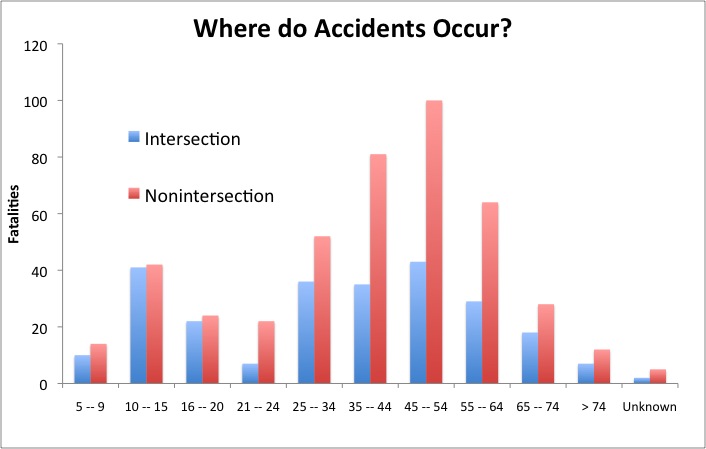Bike Fatalities, by age and location
It seems like everyone knows someone who was hit by a car in the last 3 months. I don’t know what it is about fall, but cyclists are dropping like flies, and so I’ve been thinking about bike fatalities. I dug up some numbers, and I’d like to share some graphs.
Above is the breakdown for all of the cycling accidents in 2007 (most recent numbers, as far as I know). Most people I know that were hit were in the 25-34 age group, but the most fatalities occurs in the 45-55 age group. Strange isn’t it? I’d be curious to see if this is due to an increase in accidents, or just the fact that their middle aged bodies can’t handle what a younger body could. In other words – this might be a an age where people are still active, but they don’t just roll off the hood of a car like they used to. So, be careful out there, my middle aged friends.
The next question someone might ask is “Where are these accidents taking place?”. They could occur anywhere – and indeed insurance companies and the national highway traffic administration keep track of this. The simplest distinction is between an accident that occurs in an intersection, and an accident that occurs in a non-intersection.
Here is where things get interesting: this age peak in fatalities for the 45-50 year olds virtually disappears when looking at accidents that only occur in intersections. So, this bias is due to an increase in non-intersection related accidents. I don’t know exactly why this could be. If the above hypothesis is correct – and this effect is due to an increase in fragility, rather than an increase in accidents – then perhaps there are more non-fatal non-intersection accidents for 21-24 year olds. These non-intersection accidents could be less severe for the young and rubber boned, but just fatal enough for the middle aged.
I don’t know if this is a fair assumption, but I’ve chosen it as a starting point. Whatever the truth actually is, we all have to be careful out there.


 4 Comments
4 Comments